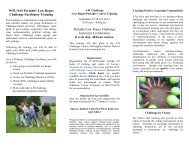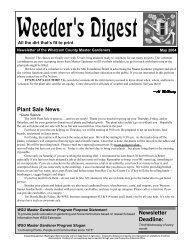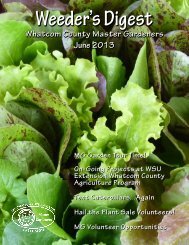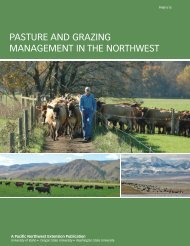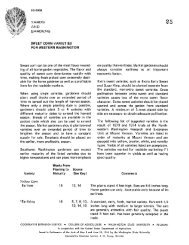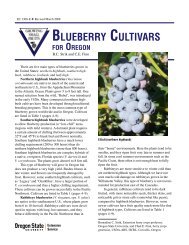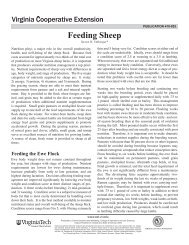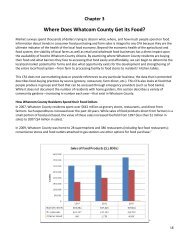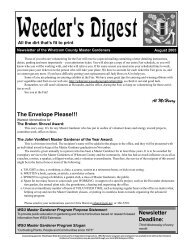Drying - Oregon State University Extension Service
Drying - Oregon State University Extension Service
Drying - Oregon State University Extension Service
You also want an ePaper? Increase the reach of your titles
YUMPU automatically turns print PDFs into web optimized ePapers that Google loves.
ContentsIntroduction 1<strong>Drying</strong> Methods 2Selecting Foods for <strong>Drying</strong> 4Preparing Foods for <strong>Drying</strong> 5Pretreating Fruits and Vegetables 6<strong>Drying</strong> in a Dehydrator 10Packaging 13Storage 14Making Fruit Leathers 15<strong>Drying</strong> Guidelines for Fruits 18<strong>Drying</strong> Guidelines for Vegetables 20Enjoying Dried Foods 23Recipes 24Questions and Answers 28The authors—Marilyn A. Swanson, former <strong>Extension</strong> Food SafetySpecialist, School of Family and Consumer Sciences, <strong>University</strong> of Idaho.Revised by Sandra M. McCurdy, <strong>Extension</strong> Food Safety Specialist, School ofFamily and Consumer Sciences, <strong>University</strong> of Idaho, in collaboration withextension specialists at <strong>Oregon</strong> <strong>State</strong> <strong>University</strong> and Washington <strong>State</strong><strong>University</strong>.Cover photo—Dishes prepared from dried fruits and vegetables (top tobottom) are Tangy Golden Fruit Snacks, Dried Vegetable Quick Bread, andTangy Stewed Fruit.
Introduction<strong>Drying</strong> foods yourself allows you to choose the best, tastiest varietiesyou can buy or pick fresh from the garden. Home drying also lets youenjoy dried fruits and vegetables the grocery stores don’t carry. Driedberries make wonderful additions to winter muffins. Dried tomatoesperk up a pot of baked beans. Backpackers let lightweight dried vegetablemixes simmer into tempting soups. And the foods you dry yourselfcost a lot less than the ones you buy.Microorganisms and enzymes that spoil food need water to be active.<strong>Drying</strong> works as a preservation method simply by depriving them ofwater.Unlike canning, in which you follow precise instructions for packagingand processing times to keep the food safe to eat, food drying isflexible. Decisions about food-piece sizes, food mixtures, pretreatments,and packaging are yours. <strong>Drying</strong> time is determined less by the clockthan by simple tests you perform.Almost any food-safe packaging will do for dried foods. And, unlikecanned foods, packages can be opened and closed again and again.High-quality, moderately priced electric dehydrators are widelyavailable. Easy to use and needing little care, they produce a consistentlytop-quality product. For these reasons, most people buy or borrowelectric dehydrators rather than use their oven or the sun. Whateverdrying method you choose, the principles in this guide will apply.1
<strong>Drying</strong> MethodsFoods can be dried in an electric dehydrator, in the sun, in a solardryer, or in a regular oven.Dehydrator <strong>Drying</strong>Dehydrator drying produces the best quality dried products, so it’snot surprising that it’s also the most popular drying method. Dehydratordrying also gives you greater flexibility than other methods because itdoes not depend on dry, sunny days or take over your oven. A variety ofelectric dehydrators are available for purchase. A dehydrator should havea heat source, a thermostat, and some method of air circulation. If youbuy a dehydrator, follow the directions that come with it.Buying a DehydratorBefore you buy a new or used food dehydrator, check to see that ithas all these features:• Instruction manual.• Thermostatically controlled temperature dial with settings between130° and 150°F.(If you plan to dry meat jerky in your dehydrator, the dehydratormust be capable of maintaining a temperature of 145˚. Contact theextension educator in your county for instructions on how to safelyprepare meat jerky.)• Fan or blower to distribute warm air evenly.• Shelves made of stainless steel or food-grade plastic. (Galvanizedscreening is not food-safe.)• Easy loading and unloading features.• Outside cabinets made of hard plastic, aluminum, or steel. Thehighest quality dehydrator hasdouble-wall construction withinsulating material sandwichedbetween the walls toreduce the amount of heat lostduring use.• Enclosed heating element.2
• Appropriate number of trays for your use. Most food dryers comewith 4 to 10 food trays.• Source of replacement parts.Sun <strong>Drying</strong>Sun drying works best when thetemperature is in the 90s, the humidity islow, and air pollution levels are low. Amajor advantage to sun drying is its lowcost. <strong>Drying</strong> trays, netting to protectagainst bugs, and food to dry are your onlyinvestments.Sun drying makes you dependent onthe weather, however. If it is sunny one dayand cloudy the next, you will have to finishdrying by another method. That’s becausespoilage can occur while the drying foodstill has enough moisture for microbial growth. Also, you should bringthe food inside on cool nights. Another disadvantage is time. What driesin 6 to 8 hours in an electric dehydrator may take 2 to 4 days in the sun.Solar <strong>Drying</strong>Solar drying is like sun drying, only better. The sun’s rays collect in asolar box so that, compared with sun drying, drying temperature ishigher and drying time is shorter. The shorter drying time gives microorganismsless chance to cause spoilage.If you do not want to buy or build a solar box, you can use the backwindow ledge of an automobile where the sun shines through. Crack thewindows slightly to allow air flow so temperatures do not get too hot.Cover the trays with netting to keep bugs out.Oven <strong>Drying</strong>You can use your oven to dry small amounts of food at one time.You’ll have little or no investment in equipment and you won’t have todepend on the weather.3
Although oven drying produces a safe, generally tasty product, don’texpect top quality. Oven-dried food is more brittle and usually darkerand less flavorful than food dried in a dehydrator. Another disadvantageof oven drying is its energy cost. Oven drying takes two or three timeslonger than drying in a dehydrator.Before drying in an oven, test the oven temperature with an oventhermometer for about 1 hour. Prop open the oven door as you wouldwhen actually drying fruit. The oven should maintain a temperature of130° to 150°F.If the oven cannot maintain a temperature in this range, you will nothave high-quality dried food. If the oven is too hot, your food will beginto cook instead of dry. If it is too cool, yourfood may not dry fast enough and spoilinstead.Selecting Foods for<strong>Drying</strong>FruitsIf you’re new to drying, start withthe fruits you like best. Think alsoabout how you will use your dried fruits.Peaches or pears in a tangy stewed fruit? Applesor apricots for lunch box snacks? Berries to toss into muffin or cakebatters? Most fruits are easy to dry.High-quality fruits make the best dried products. Choose firm, fullyripe fruit that is heavy for its size. Handle fruits gently and process themimmediately because fruit ready for drying is very fragile. Use overripe orbruised fruits in other ways (for example, as fruit leathers).VegetablesVegetables for drying should be fresh, tender, and just mature. Avoidimmature vegetables because their color and flavor tend to be weak orpoor. Also avoid excessively mature vegetables, which are inclined to betough, woody, or fibrous. For the best quality and nutrition, dry vegetablesas soon as possible after harvest.4
Preparing Foods for <strong>Drying</strong>For suggestions for specific fruits and vegetables, see the dryingguidelines beginning on page 18.FruitsGently wash all fruits in cold water just before drying to remove dirt,bacteria, and insects. Thoroughly wash fruits that have skins you will notpeel off, such as cherries and prunes. Do not soak fruit because extendedsoaking can cause nutrient loss and waterlog the fruit, which increasesdrying times.Remove fruit stems and peels. Peels may be left on some fruits, suchas apples and peaches, but they may become bitter or discolor duringdrying. Core or pit the fruit and cut it into uniform halves, quarters, orslices. Trim away diseased or soft spots.VegetablesWash vegetables in cold water just before drying. If vegetables arecovered with soil, wash them under clean running water to prevent thedirt from resettling on the food. Do not allow vegetables to soak inwater.Most vegetables should be peeled and trimmed then cut, sliced, orshredded into uniform pieces. Although peeling some vegetables such asyoung zucchini and well-washed carrots is optional, unpeeled vegetablestend to be tougher when dried. Remove fibrous or woody portions anddamaged areas. You can prepare pieces with a food slicer or food processor.5
Pretreating Fruits and VegetablesSee the drying guidelines on pages 18 through 22 for specific details.Although you can dry and store many foods without pretreatment,pretreatment generally improves quality, particularly for vegetables. Fivemajor reasons for treating foods before drying are to1. Preserve color and flavor2. Minimize nutrient loss3. Stop decomposition (enzyme action)4. Ensure more even drying5. Extend storage lifePretreatment Methods for Fruits and VegetablesFruitsVegetablesAscorbic acid/citric acid dips Steam blanchingSalt solution dipWater blanchingSyrup blanchingHoney dipSulfitingPretreating FruitsDecomposition from enzyme action during storage is less a problemwith fruits than it is with vegetables. Fruits have higher levels of sugarand acid, which counteract enzyme action. Although pretreating fruit isnot necessary, you can use an ascorbic acid/citric acid dip, a salt solutiondip, syrup blanching, a honey dip, or a sulfiting procedure. Certainfruits, such as apricots, pears, peaches, and some varieties of apples, tendto discolor with drying. Pretreating those fruits can decrease browningduring processing and storage and lower losses of flavor and of vitaminsA and C.If you use a pretreatment method that requires soaking fruits in a watersolution, you will need to increase drying time because the fruit will absorbsome water. Do not allow foods to soak more than 1 hour.6
Ascorbic Acid/Citric Acid Dips. Ascorbic acid/citric acid dips areoften used as a pretreatment for fruits. They prevent fruits such asapples, pears, peaches, and apricots from turning brown when cut andexposed to air. An ascorbic acid dip also increases the vitamin C contentof the dried fruit. (Ascorbic acid is another name for vitamin C.) UseU.S.P. ascorbic acid or food-grade ascorbic acid, which are seasonallyavailable among canning supplies in supermarkets. Vitamin C tablets canalso be used.To prepare an ascorbic acid solution, combine 1 /2 teaspoon of ascorbicacid crystals, or three crushed, 500-milligram tablets of vitamin C,with 1 quart water. Stir until the ascorbic acid dissolves. Place the cutfruit in the ascorbic acid solution. Stir the fruit to ensure even coating.Leave the fruit in the ascorbic acid solution for about 5 minutes. Approximately1 quart of solution will treat 8 cups of fruit.Pineapple juice or juice from citrus fruits such as oranges, lemons, orgrapefruit can also be used as a pretreatment. These juices contain amixture of citric and ascorbic acids. However, citric acid is a weaker acidthan ascorbic acid and is less effective as a pretreatment.You can also use a commercial pretreatment such as the anti-darkeningpowders often sold with food preservation supplies. Follow the labeldirections.Salt Solution Dip. Prepare a solution of 2 to 4 tablespoons of saltper gallon of water. Soak fruit for 2 to 5 minutes, and then drain it well.Syrup Blanching. Prepare fruit for drying. Prepare a sugar syrupmade with 1 part sugar and 2 parts water. If desired, use less sugar. Bringthe syrup solution to a boil. Add the fruit, simmer for 5 minutes, thendrain the fruit. Place the fruit on drying trays and dry. This fruit productis like a candied fruit.Honey Dip. A honey treatment for fruit can effectively minimizebrowning and softening in light-colored fruit. Prepare a honey-water dipusing 1 part honey to 4 parts water. Dip the fruit in the honey solutionimmediately after slicing, let it soak for about 5 minutes, and drain well.The dried fruit will have a slight honey taste.Sulfiting. Sulfur dioxide treatments, either sulfiting or sulfuring, arevery effective for retarding oxidation and browning in fruit. Fruit flavorand storage life may also improve. Almost all commercially producedlight-colored fruits, such as dried apples, pears, and apricots, are treatedwith sulfur compounds.7
However some people have severe allergic responses to sulfur compounds.They should not eat or work with dried fruit pretreated withsulfur or sulfite compounds.Sulfuring, a complicated and potentially dangerous procedure, isno longer recommended.Sulfiting involves preparing a solution of water and a sulfiting agentand then soaking the cut fruit in the solution. In the United <strong>State</strong>s sixsulfur compounds (sulfur dioxide, sodium sulfite, sodium bisulfite,potassium bisulfite, sodium metabisulfite, and potassium metabisulfite)have been listed by the U.S. Food and Drug Administration (FDA) as“Generally Recognized as Safe” (GRAS). The most popular sulfitingagents for home drying are sodium bisulfite, sodium sulfite, and sodiummetabisulfite. They should be either U.S.P. (food grade) or reagent grade(pure). They are available at most wine-making supply centers and somelarger supermarkets.Amount of sulfur to add per quart of waterSodium bisulfite1/2 to 1 teaspoonSodium sulfite1 to 2 teaspoonsSodium metabisulfite 1 to 3 teaspoonsThe sulfiting process has two steps:1. Prepare the sulfiting solution in a large glass container just beforeuse. Place the cut fruit in the solution. Do not leave the fruit in thesulfiting solution too long or the fruit will be mushy. Use about 10minutes for sliced fruit and 30 minutes for halved fruit. Do notexceed the recommended quantities of sulfites or soak times.2. After sulfiting, remove the fruit and drain it well. Some peoplerecommend a quick rinse in cold water before drying. Place sulfitedfruit on drying trays and dry. <strong>Drying</strong> times for sulfited fruits arelonger because the fruit absorbs some water during soaking.Allergic Reactions to SulfitesSome individuals, particularly those with asthmatic conditions,are highly sensitive to sulfites. During the drying process, most of thesulfites enter the air, leaving only a trace on the fruit. Nevertheless,this trace may cause severe allergic reactions in sensitive individuals.Sensitive individuals should not eat food treated with sulfites orprepare soaking solutions with sulfites. If you use a sulfiting pretreatmentwhen drying foods, be sure to say so on the label.8
Pretreating VegetablesBlanching (heating in boiling water or steam) is the pretreatmentmethod of choice for vegetables. Almost all vegetables should beblanched before drying to destroy the enzymes that make vegetablesdeteriorate. Blanching keeps vegetables from browning, becoming bitter,or developing off flavors. Blanching also cleans and softens vegetablesand makes them easier to rehydrate later. Although you can use eitherboiling water or steam for blanching, vegetables lose more nutrientsduring boiling.Steam Blanching. Use a steamer or make a steamer out of a kettlewith a tight-fitting lid. Place a colander, wire basket, or sieve inside thekettle. Make sure the food will be above the water level. Add 2 inches ofwater to the kettle and heat it to boiling. Place the container with theloosely packed food in the steamer, cover the kettle tightly, and continueboiling.Water Blanching. Fill a kettle with enough water to cover the food.Bring the water to a rolling boil and gradually stir in the food. Cover thekettle tightly and boil. You can reuse the water when blanching more ofthe same food, adding more water as necessary. If the water appears dirty,replace it with clean water.Determining Blanching Times. Blanchingtimes vary with altitude (higher altitudes requirelonger blanching times), the type and textureof the vegetable, the amount of vegetable,and the thickness of the pieces. Generally,vegetables should feel and taste firm yettender. They should not be fully cooked,but they should be heated all the waythrough. Test the food by cuttingthrough a piece. If sufficientlyblanched, it will appear cooked (translucent)nearly to the center.The drying guidelines on pages 18-22 suggest blanching times, but youshould test the food frequently to avoidover- or underblanching.Underblanching may cause deteriorationin storage, poor rehydration, orbad color. Overblanching makes9
vegetables lose color, flavor, andnutrients and gives them poortexture after rehydration.After Blanching. Drainvegetables by pouring themdirectly on the drying trays.If you plan to reuse the water,place a large pan under thetrays. Wipe the bottom of thedrying tray with a clean towel toremove excess water. Draining thevegetables on one tray and then transferring them to the drying trayresults in unnecessary handling. Immediately transfer the blanchedvegetables into the dehydrator so drying can begin while the vegetablesare still warm.<strong>Drying</strong> Canned Fruits and Frozen VegetablesUsing canned fruits is a quick way to prepare fruit for drying.Drain the syrup, rinse the fruit, and cut it into 1 /2-inch slices, ifdesired, then dry as usual. <strong>Drying</strong> times will be longer than for freshfruit because the canned fruit will contain absorbed syrup. Driedcanned fruit resembles candied fruit and can be used in similar ways.Likewise, frozen vegetables can be thawed, drained, and dried.Blanching was taken care of before freezing.<strong>Drying</strong> in a DehydratorDistribute the food on trays in a single layer. Different foods can bedried at the same time, but try to choose foods that will dry in about thesame amount of time. (Dry similarly sized pieces together.) Onions,peppers, and other strong foods tend to flavor other foods, so dry themseparately.Moisture must be removed from the food as quickly as possible at atemperature that does not seriously impair the flavor, texture, or color ofthe food. If the temperature is too low at the beginning, the food mayspoil before it dries. If the temperature is too high, the surface may10
harden so that the interior dries much more slowly. Start the dryer at140° to 150°F, with the exceptions noted in the drying guidelines (page18). After 2 to 3 three hours, lower the dryer temperature to 130°F to140°F. Adequate air flow can reduce drying times.Monitor the drying process. If necessary, rotate the trays to ensureeven drying. You may need to stir grated, shredded, or finely cut foods.<strong>Drying</strong> TimeMany factors affect drying time, including type of food, size andmoisture content of the food pieces, pretreatment method, dryer type,dryer temperature, relative humidity of the air, and amount of airmovement in the dryer and in the surroundings. With so many factors atwork, it’s impossible to give precise drying times.Generally, you can figure on drying times of 6 to 36 hours for fruitand 3 to 16 hours for vegetables, which take less time due to their lowersugar contents. Check the instructions that come with your dehydrator,and read the general guidelines for drying times for various foods givenon pages 18-22. In the end, you need to decide when food is dry.Vegetables are sufficiently dry when they are brittle or leathery.Leathery vegetables will be pliable and spring back if folded. Brittlevegetables such as corn and peas will shatter when hit with a hammer.Fruits are sufficiently dry when they are pliable and leatherlike andhave no pockets of moisture.Herbs are sufficiently dry when brittle. Their leaves will shatter whenrubbed together.When you think the food is sufficiently dry, remove a piece andallow it to cool completely. Then check for dryness. (Refer to the dryingguidelines on pages 18-22 for specific information.) When you are indoubt about the dryness of a food, continue to dry it. Foods dry morequickly toward the end of the drying period, so check them frequently,and avoid leaving them in the dryer after they are done. Leaving them inwill reduce their quality.11
<strong>Drying</strong> for Top Nutrition• Don’t overblanch.• Dry foods as quickly as possible without raisingthe temperature above 150°F initially or above 140°Ffor the remaining drying time. Dry herbs, coconut, andmushrooms at lower temperatures.• Do not overload the dryer.• Keep the food on the drying trays well spaced withno overlapping.• Keep good air circulation to quickly move moistureaway from the drying food.• If possible, dry when the relative humidity is low.• Check to be sure foods are sufficiently dry.• Condition dried fruits.• Store dried foods in packages that do not admitmoisture or oxygen.• Store dried foods in a cool, dark, dry place.• Store in amounts that can be used easily at one time.12
PackagingGood packaging and storage techniques are crucial. Packagingprotects your dried food from oxygen, moisture (gain or loss), light,microorganisms, and pests. After you have checked foods and foundthem to be thoroughly dry and cool, pack them immediately for storage.Conditioning FruitsSome pieces of fruit will be more moist than others after drying so itis a good idea to condition fruits before long-term storage. Conditioningdistributes moisture evenly in the fruit. It reduces the chance of spoilage,particularly from mold.To condition, loosely pack cooled, dried fruit in plastic or glasscontainers to about two-thirds full. Cover the containers tightly. Shakethem daily for about 2 to 4 days. The excess moisture in some pieces willbe absorbed by the drier pieces. If you notice water forming on thecontainer lid, place the fruit back in the dehydrator. Because vegetablesdry to a nearly waterless state, conditioning vegetables is not necessary.Choosing ContainersThe ideal container for a dried food is:• Clean and sanitary• Nontoxic• Lightweight• Easily disposable or recyclable• Moisture resistant• Airtight• Protective against light• Easily opened and closed• Impermeable to gases and odors• Durable• Low-costUnfortunately no single food container has all these characteristics.Make your choice based on the type of dried food, your intended storageconditions, and storage time. Three materials—glass, plastics, and metal13
(never galvanized steel)—are used for packaging most dried foods. Evenopen-and-close plastic bags are suitable.One good method of storing dried food is to place sealed plastic bagsinside a larger glass or metal container with a tight-fitting lid. This twosteppackaging has the advantages of being relatively easy, allowing morefood to be stored in one container, and protecting against insects andother pests. Although you could store more than one type of dried foodinside the larger glass or metal container, do not combine foods withstrong odors such as onions, cabbage, or broccoli because other driedfoods may absorb their odors.LabelingLabel each package with the type of food, pretreatment step, anddate. Labels may be taped on the outside of a package, tied on withstring, or inserted into a clear glass or plastic package. With proper labelsyou will not have to open individual packages each time you want to usea dried food.StorageThe length of time you can store dried food depends on• The type of food• Factors related to the drying process (pretreatmentand final level of moisture in the dried food)• Packaging of the dried food• The storage areaAn ideal storage area for dried food is cool, dark, anddry. The cooler the storage area, the longer the shelflife. Dark areas are ideal because light fadesfruit and vegetables and decreases theirvitamin A and C contents.The storage area need not be fancy; adark, unheated closet or drawer worksfine. Metal containers have the advantage ofkeeping their contents in darkness. Glass orplastic containers can be covered with a cardboardbox, a barrel, or black plastic to keep light out.14
Many people store dried foods in the refrigerator or freezer, which keepsquality high.During storage at room temperature, the most common type ofspoilage is mold growth. Molds can grow in foods that are not completelydry and in foods that absorb water when they are packaged orstored in moist conditions. (Remember: don’t consume moldy foods.Some toxic molds can grow at room temperature.) Dried food willprobably not absorb enough water to allow bacterial or yeast spoilage.One typical change that occurs during storage is “Maillard browning,”which involves complex chemical reactions between the food’ssugars and proteins. Other chemical changes that may take place duringstorage include loss of vitamin C or other nutrients, general discoloration,changes in food structure leading to an inability of the dried foodto fully rehydrate, and toughness in the rehydrated cooked product.Making Fruit LeathersFruit leathers are a wonderful way to use small quantities of fruit orextra-ripe fruit. Fruit leathers, also known as fruit paper and fruit taffies,are chewy fruit roll-ups made from either cooked or uncooked fruitpurée.Fruit leathers allow for individual creativity through combinations ofdifferent fruits. Generally you can use any kind of fruit, includingapples, bananas, berries, grapes, mangos, papayas, peaches, pears, pineapple,plums, and even tomatoes. Citrus fruits alone are generally notrecommended. Fruit leathers are an excellent use for slightly overripe orbruised fruit that would otherwise be discarded.Uncooked Fruit Leathers1. Select ripe or overripe fruit or fruit combinations.2. Wash fruit and cut away blemishes. Remove stones or pits. Removelarger seeds from berries, grapes, and tomatoes if you wish. Peel alltough-skinned fruits; peel others if you wish.3. Cut fruit into chunks and place them in a food chopper, blender, orfood processor.4. Add 1 tablespoon lemon or other citrus juice per quart of yellow orlight-colored fruit, if desired, for keeping fruit color.15
5. Chop, grind, or blend the fruit into a thick purée. If the fruit haslittle juice, add several spoonfuls of water or fruit juice to obtain auniform purée. (If uncooked fruit purée is too juicy, it can becooked to remove excess liquid.)6. (Optional) Add sugar, honey, or corn syrup to taste. (Generally noadditional sweetener is needed, particularly with ripe fruit, becausefruit tastes sweeter after being dried.)7. (Optional) Add spices (for example, cinnamon, nutmeg, cloves,allspice) to taste. Start with 1 /2 teaspoon dried spice per quart ofpuréed fruit; spice flavors intensify during drying.8. Use a drying tray designed for fruit leather or line a portion of adrying tray with lightly oiled heavy plastic wrap. Do not completelycover the tray with plastic wrap or the air will be unable to circulateto other trays. Pour a small amount of purée onto the lining wrap.Make sure the tray has an edge to prevent spillage. Tilt the trayuntil the purée spreads no more than 1 /4 inch thick almost to theedge of the plastic wrap. (Two cups of purée will cover a 12- by 17-inch drying tray.)9. (Optional) Sprinkle the purée with chopped nuts, seeds, or gratedcoconut.Cooked Fruit Leathers (Double-Boiler Method)1. Select, wash, and prepare fruit as described for uncooked fruitleather.2. Cut the fruit into slices or chunks and place them in the top of adouble boiler.3. Add water to the bottom of the double boiler. Cover the doubleboiler and steam the fruit for 15 minutes or until fruit is soft. (If adouble boiler is not available, you can place a small pan containingthe fruit in a larger pan that is partially filled with boiling water.)4. Follow steps 4-9 for uncooked fruit leather.16
Cooked Fruit Leathers (Microwave Method)1. Select, wash, and prepare fruit as described for uncooked fruitleather.2. Cut the fruit into slices or chunks and place them in a microwavesafebowl.3. Cover the bowl with plastic wrap or a microwave lid.4. Microwave on high for 4 minutes, stir, and rotate the bowl. Continuestirring and rotating the bowl every 4 minutes until fruit issoft.5. Follow steps 4-9 for uncooked fruit leather.Fruit Leather from Canned Fruit1. Thoroughly drain home-canned or commercially canned fruit oruse baby food fruit without tapioca.2. Follow steps 3 and 5-9 for uncooked fruit leather. Since cannedfruits have been heat processed to stop enzymatic action, you don’tneed to add ascorbic acid.<strong>Drying</strong> and Storing Fruit LeathersPlace prepared trays in the dehydrator. Dry until the leather is sticky,generally 6 to 8 hours at 140°F. Properly dried fruit leather will betranslucent and slightly tacky to the touch but will still peel away fromthe plastic wrap.Lift an edge of the leather, which should stick tightly to the surface,and peel it back slightly. If the leather peels away readily, it is dry. If theleather has cooled, it may need to be warmed slightly for a few minutesto help it peel away. If the fruit leather cracks or chips, it has dried toolong, but it is still edible. Remove the remainder of the plastic wrap. Ifpart of the leather is still sticky, you can dry it more without the plasticwrap.After drying the fruit leather, leave it whole or cut it into pieces. Thefruit leather can be rolled and wrapped in plastic wrap or stored flat insheets with plastic wrap separating each sheet. Place the wrapped piecesin an air-tight container in a cool, dark, dry place. You can also storefruit leather in the refrigerator or freezer.17
<strong>Drying</strong> Guidelines for FruitsFruitSelection and preparation(thoroughly wash all fruits)PretreatmentTests for drynessand drying timeguidelines*ApplesPeel (optional) and core. Cut intoslices or rings about 1 /4-inchthick.None, ascorbic acid/citricacid dip, syrup blanch,honey dip, or sulfitingLeathery to crisp;no moist area incenter6-12 hoursApricotsCut in half and pit. Fruits drymore rapidly if quartered orsliced.Ascorbic acid/citric acid dip,syrup blanch, honey dip, orsulfitingSpringy; no moist areain center24-36 hours for halvesBananasPeel and slice 1 /4 to 1 /2-inchthick, crosswise or lengthwise.None or ascorbic acid/citricacid dipPliable to crisp8-10 hoursBlueberries/HuckleberriesRemove stems.None or dip larger berries inboiling water to crack theskinsShriveled; leathery24-36 hoursCherriesRemove stems. Slice in half andremove pit, or pit and drywhole.None or sulfitingPliable; leathery24-36 hoursCoconutsDrain milk. Steam fruit 1 minuteto loosen meat or pry meat outwith a knife. Trim dark outerskin, and grate meat or slice inchunks.NoneLeathery to crispDry at 110˚CranberriesRemove stems.Dip in boiling water to crackskinsShriveled24-36 hoursFigsIf figs are small or have partlydried on the tree, they may bedried whole. Otherwise, cut inhalf. Dry with skin-side down.None, or syrup blanchPliable; leathery;slightly sticky; nomoist area in center6-12 hoursGrapesSelect seedless varieties.Dip in boiling water 30seconds to crack skins.Plunge in ice water to stopcooking. Drain on papertowels.Pliable; leathery12-20 hours*<strong>Drying</strong> times are guidelines only. Test food frequently for dryness according to the criteria described in thechart. Cool food before testing.18
<strong>Drying</strong> Guidelines for Fruits (cont.)FruitSelection and preparation(thoroughly wash all fruits)PretreatmentTests for drynessand drying timeguidelines*Kiwi fruitRemove outer skin. Slice 1 /4-inchthickNonePliable; leatheryPapayasCut in half and remove seeds.Peel and slice.None, or syrup blanchPliable; leatheryPeachesPeel and slice peaches. Fruits drymore rapidly if quartered orsliced.None, ascorbic acid/citric aciddip, syrup blanch, honey dip,or sulfitingPliable; leathery24-36 hours for halvesPearsPeel, cut in half lengthwise, andcore. Section or slice about1/4-inch thick.None, ascorbic acid/citric aciddip, syrup blanch, honey dip,or sulfitingPliable; leathery24-36 hours for halvesPineapplesPeel and remove thorny eyes; cutinto 1 /4-inch-thick slices.None, or syrup blanchLeathery but notsticky24-36 hoursPlumsCut in half and pit. Fruits drymore rapidly if quartered orsliced.None, or sulfiting for lightcoloredfruitPliable; leathery24-36 hours for halvesPrunesCut in half and pit. Fruits drymore rapidly if quartered orsliced.NonePliable; leathery;a handful ofproperly driedprunes will fall apartafter squeezing24-36 hours for halvesRhubarbCut in 1-inch lengths.Blanch for 1-2 minutesVery brittle; toughStrawberriesRemove stems. Cut strawberriesin half. Dry skin-side down.NonePliable; leathery*<strong>Drying</strong> times are guidelines only. Test food frequently for dryness according to the criteria described in thechart. Cool food before testing.19
<strong>Drying</strong> Guidelines for VegetablesVegetableSelection and preparation(thoroughly wash allvegetables)Pretreatment andblanching timeguidelines*Tests for drynessand drying timeguidelines*BeetsSelect small, tender beets of goodcolor and flavor, free fromwoodiness. Steam or boil untilcooked through. Cool, trim offroots and crowns, and peel. Cutinto shoestring strips or intoslices about 1 /4-inch thick.Steam or boil until tender25-30 minutes for smallbeetsTough; brittle10-12 hoursBroccoliTrim and cut as for serving.Quarter stalks lengthwise.Water or steam blanch2-3 minutes in water3-5 minutes in steamCrisp12-15 hoursCabbageRemove outer leaves, quarter, andcore. Cut into shreds about1/8-inch thick.Steam blanch2-3 minutesCrisp10-12 hoursCarrotsSelect crisp, tender carrots, freefrom woodiness. Wash; trim offthe roots and tops. Cut intoslices or strips about 1 /4-inchthick.Steam blanch3-4 minutesTough; brittle10-12 hoursCauliflowerSeparate into flowerets; cut largeones in half.Water blanch (add 1tablespoon vinegar per1 gallon water)3-4 minutesTough; brittle12-15 hoursCeleryStrip off leaves; cut stalks into1/4-inch pieces. Stir occasionallyduring drying.Water blanch30 seconds to 2 minutesCrisp10-16 hoursCorn(cut)Select tender, sweet corn. Husk.Steam on the cob for 5 to 10minutes, or until milk is set.Cut from cob.Steam blanchCrisp; brittle6-10 hoursGreen beansRemove defective pods. Removestrings if necessary. Split podslengthwise to hasten drying.Water or steam blanch2-3 minutes in water3-4 minutes in steamBrittle8-14 hours*Blanching and drying times are guidelines only. Test food frequently for dryness according to the criteria described in thechart. Cool food before testing.20
<strong>Drying</strong> Guidelines for Vegetables (cont.)VegetableSelection and preparation(thoroughly wash allvegetables)Pretreatment andblanching timeguidelines*Tests for drynessand drying timeguidelines*Mushrooms Slice off woody stems. Slice, ordry whole if small. Spread notmore than 1 /2-inch deep ontrays.NoneWarning: Use only commercially grown mushrooms.Only an expert can differentiate between poisonous and edible varieties.Crisp; brittleDry at 120˚FOkraUse young, tender pods only. Cut1/2-inch crosswise, slice, or splitlengthwise. Spread not morethan 1 /2-inch deep on trays.Water blanch2-3 minutesTough; brittle8-10 hoursOnionsRemove outer, discolored layers.Slice 1 /4-inch thick or chop.NoneBrittle; light colored;feels like paper3-9 hoursParsleyand other herbsNo precooking necessary. Hangbunches or whole plants in adry, warm place to dry. Whendry, crush leaves and removestems. When drying indehydrator or oven, keeptemperatures below 120°F.NoneBrittleDry at 100˚F1-2 hours in adehydratorParsnipsSelect crisp, tender parsnips, freefrom woodiness. Wash; trim offthe roots and tops. Cut intoslices or strips about 1 /2-inchthick.Water or steam blanch2-3 minutes in water3-5 minutes in steamTough; brittlePeasSelect young, tender peas of asweet variety. Shell. Stirfrequently while drying.Steam blanch quicklyafter shelling2-3 minutesHard; wrinkled;shatter when hitwith a hammer8-10 hoursPeppers(green, red, oryellow)Cut in 1 /2-inch strips or rings.Remove seeds and “partitions.”Spread rings two layers deep;spread strips not more than1/2-inch deep.None, or water or steamblanch2-3 minutes in water3-5 minutes in steamTough; brittle8-12 hours*Blanching and drying times are guidelines only. Test food frequently for dryness according to the criteria described in thechart. Cool food before testing.21
<strong>Drying</strong> Chart for Vegetables (cont.)VegetableSelection and preparation(thoroughly wash allvegetables)Pretreatment andblanching timeguidelines*Tests for drynessand drying timeguidelines*PotatoesPeel; cut into shoestring strips3/16-inch in cross section orslice about 1 /4-inch thick.Rinse in cold water.Water or steam blanch,and rinse well.5-6 minutes in water6-8 minutes in steamCrisp8-12 hoursPumpkin, yellowChop into strips about 1-inchwide. Peel off rind; scrape offfiber and seeds. Cut peeledstrips into pieces about1/8-inch thick.Water or steam blanch untiltender1 minute in water2-3 minutes in steamTough to brittle10-16 hoursSoybeansSpinachand other greensBlanch pods until beans aretender but firm. Shell.Select young, tender leaves.Wash. See that leaves do notform wads when placed ontrays. Cut large leavescrosswise into several pieces.Water or steam blanchWater or steam blanch untilwiltedShatter when hit witha hammerBrittleSquash(Hubbard orwinter types)Chop into strips about 1-inchwide. Peel off rind; scrape offfiber and seeds. Cut peeledstrips into pieces about1/8-inch thick.Water or steam blanch untiltender1 minute in water2-3 minutes in steamTough to brittle10-16 hoursSquash(summer, crookneck,scallop, zucchini,etc.)Wash, trim, and cut into1/4-inch-thick slices.None, or water or steamblanchLeathery to brittle10-12 hoursTomatoes(meaty varieties)Select tomatoes of good color.Steam or dip in boiling waterto loosen skins. Chill in coldwater; peel. Cut into sectionsnot more than 3 /4-inch wide.Cut small pear or plumtomatoes in half.NoneLeathery to crisp10-18 hours*Blanching and drying times are guidelines only. Test food frequently for dryness according to the criteria described in thechart. Cool food before testing.22
Enjoying Dried FoodsYou can eat dried fruits plain or mix them with nuts and seeds for ahealthy mixed snack. Use chopped dried fruit or whole dried berries orcranberries instead of raisins or nuts in cakes, quick breads, and cookies.Dried vegetables make excellent additions to homemade soups andstews. Generally you should soak root crops such as beets, carrots, andpotatoes before adding them to a soup, stew, or casserole. Most otherdried vegetables can be added directly. (You may need to increase cookingtime and add extra liquid to be sure the vegetables are tender.) Driedleafy vegetables can be powdered in a blender or food processor thenstirred into soups or purées.To prepare a dried soup mixture, cut fresh vegetables into smallpieces then dry them according to the directions for each vegetable. Afterdrying, combine and store them. Cabbage, carrots, celery, corn, onions,and peas make tasty combinations. Rice, dry beans, split peas, and meatstock are usually added at the time of cookingPlumping and Rehydrating Fruits and VegetablesFruits. To plump or soften dried fruit to make it more chewable,cover it with boiling water, let it stand for 5 minutes, and drain.Vegetables. When you soak or rehydrate dried vegetables, theyshould plump to nearly the same size they were when fresh. Start with1 1 /2 to 2 cups cold water for each cup of dried vegetable. Keep thevegetables covered with water during soaking by adding more water, ifnecessary. Rehydrating root vegetables takes about 1 /2 to 2 hours, dependingon the size of the pieces.If you are adding dried vegetables to a soup or stew, don’t worryabout rehydrating them; just toss them in.23
RecipesVegetable SoupServes 64 cups water3/4to 1 cup dried vegetables(green beans, corn, peas, tomatoes, onions, etc.)2 packages bouillon granules or cubesSeasonings to taste (herbs, soy sauce, or curry)Variation: Add 1 /2 cup rice, noodles, lentils,or barley with the other ingredients.1. Bring water to a boil. Add dried vegetables, bouillon,and seasonings.2. Simmer about 20 minutes or until vegetables are tender, thoughchewy. (Freshly dried vegetables will not take as long to reconstituteas those that have been stored for a long time.)3. Remember to refrigerate leftovers.Dried Vegetable Quick BreadMakes 2 loaves3 cups flour1 teaspoon ground cinnamon2 teaspoons baking soda1/2 teaspoon baking powder3/4 cup honey3 beaten eggs1 cup oil2 teaspoons vanilla or other flavor extract2 cups finely chopped, rehydrated vegetables(about 1 1 /2 cups dried)(optional) 1 /2 cup raisins or other chopped dried fruit1. Using equal amounts of dried vegetables and water, cover thevegetables with cool water. Soak for 15 to 60 minutes, until soft.Drain and set aside.2. Combine flour, cinnamon, baking soda, and baking powder in alarge bowl. Set aside.24
3. In another bowl, mix the honey, eggs, oil, vanilla flavoring, and 2cups of the rehydrated vegetables.4. Pour the honey mixture into the flour mixture. Mix well until theflour is completely moistened.5. Add raisins or dried fruit, if desired.6. Pour into two greased and floured 7- by 3-inch loaf pans.7. Bake at 350°F for about 50 minutes. Test for doneness by insertinga toothpick into the center. If it comes out clean, the loaves aredone.Tangy Golden Fruit SnackMakes about 36 balls1/2cup dried apricots1/2cup dried apples1/2cup dried peaches1/2cup finely grated dried coconut1/4cup finely chopped nuts1 teaspoon finely grated citrus fruit peel (orange, lemon, lime)1/2 teaspoon cinnamon1/4 cup honey (you may want to add 1 more tablespoon ofhoney if you are using a tart juice such as lemon juice)1/4 cup citrus juicePowdered sugar, if desired1. With a food processor or grinder, grind apricots, apples, andpeaches into bits about half the size of a raisin or about 1 /8 inchin diameter. Place in a medium bowl.2. Stir in coconut, nuts, citrus peel, and cinnamon.3. Slightly warm honey and citrus juices. Stir to mix well.4. Slowly pour the honey mixture over the fruit mixture, stirring untilthe mixture sticks together evenly.5. Form into balls 3 /4 to 1 inch in diameter (about 1 rounded teaspoon)and place on drying racks.6. Dry in food dryer until no longer sticky to the touch (2-3 hours).7. If desired, roll balls in powdered sugar.25
Dried Berry CobblerFilling2 cups dried blueberries, cranberries, gooseberries, or other berry2 cups boiling water2 tablespoons tapioca1 to 1 1 /2 cups sugar, depending on tartness of berries1. Pour boiling water over the berries and let them soak for3 to 4 hours.2. Place soaked berries and liquid in a shallow baking dish.3. Combine sugar and tapioca; sprinkle over the berries.4. Cover the berries with batter (see below), and bake30 minutes at 400°F.Batter1/4 cup butter or margarine1/2 cup sugar1 egg, well beaten1 1 /2 cups flour2 teaspoons baking powder1/2 teaspoon salt1/2 cup milk1. Cream together butter and sugar. Add beaten egg.2. Thoroughly mix flour, baking powder, and salt.3. Add the flour mixture to the butter mixture one-half cup at a time,alternately with the milk.26
Dried Fruit Rice Pudding1/4 cup uncooked rice1/2 cup sugar4 cups milk1/4 teaspoon ground ginger1/4 teaspoon salt3/4 cup dried fruit, cut into small pieces (not dried bananas)1. Combine all ingredients in a large casserole.2. Bake, uncovered, in a 300°F oven for 2 1 /2 hours, or until rice istender, stirring occasionally. Occasional stirring is especially importantduring the first hour of baking.3. Cool. Serve cold.Tangy Stewed Fruit2 to 3 cups dried fruit such as apples, apricots, cherries, figs,nectarines, peaches, pears, pineapple, cranberries, or prunes2 1 /2 cups boiling water1 tablespoon lemon juice1/2 cup orange juice2 tablespoons sugar1/2 teaspoon cinnamon1/4 cup honey1. Pour boiling water over dried fruit in a medium saucepan.Let stand to soften 5 to 15 minutes.2. Add orange and lemon juices. Bring to a boil.3. Simmer 20 minutes.4. Stir in sugar, cinnamon, and honey. Mix well.5. Serve hot or cold.27
Questions & AnswersI did not pretreat my pears before drying them. Now they arequite dark in color. Are they safe to eat?Yes, the pears are still good to eat. Pretreating helps tostop the enzyme action that darkens light-colored fruit. Also,storing your dried fruit at cool temperatures helps to preventthe browning reaction that occurs during prolonged storage.My dried apples molded. Can they be rescued?No. Throw them out. The next time you dry fruit, eitherremove more of the moisture so mold cannot grow or storethe dried fruit in the freezer.My banana chips don’t taste like the ones in the store.What can I do?There are several varieties of banana chips available. Readthe ingredients on their labels. Some banana chips are dippedin honey, and some are dipped in granulated sugar, brownsugar, or flavored gelatin. Be sure the bananas you dry areripe. Some commercial banana chips have been treated tomake them crisp, but this isn’t possible to do at home.What can I do about insects that may have contaminated mysun-dried vegetables?To kill any insects or insect eggs that may have contaminatedfoods left to dry in the sun, place the packaged driedfoods into your home freezer at 0°F for 48 hours. Or, pasteurizethem for 30 minutes without packaging in a 150°F oven.Store-bought dried fruits are softer and moister than mine.How can I achieve this at home?Commercially prepared fruits do have a higher moisturecontent, but they also contain preservatives to prevent moldgrowth at room temperature. If you want to slightly underdryyour fruits to keep them soft, plan to store them in thefreezer.28
More Pacific Northwest FoodPreservation PublicationsCanning Fruits PNW 199Canning Meat, Poultry, and Game PNW 361Canning Seafood PNW 194Canning Tomatoes and Tomato Products PNW 300Canning Vegetables PNW 172Fish Pickling for Home Use PNW 183Freezing Fruits and Vegetables PNW 214Freezing Prepared Foods PNW 296Home Canning Smoked Fish PNW 450Pickling Vegetables PNW 355Recetas Para El Envasados de SalsasPNW 395SSalsa Recipes for Canning PNW 395Smoking Fish at Home—Safely PNW 238Using and Caring for Your Pressure Canner PNW 421To order in Idaho, contact:Ag Publications, <strong>University</strong> of Idaho, Moscow, ID 83844-2240(208) 885-7982http://info.ag.uidaho.eduIn <strong>Oregon</strong>, contact:Publication Orders, <strong>Extension</strong> & Station Communications,<strong>Oregon</strong> <strong>State</strong> <strong>University</strong>, 422 Kerr Administration,Corvallis, OR 97331-2119Fax: (541) 737-0817Puborders@orst.edu, http://eesc.orst.eduIn Washington, contact:Bulletin Office, Cooperative <strong>Extension</strong>, Washington <strong>State</strong><strong>University</strong>, P.O. Box 645912, Pullman, WA 99164-5912(509) 335-2857, (800) 723-1763
Pacific Northwest <strong>Extension</strong> publications are jointly produced by the three Pacific Northweststates—Idaho, <strong>Oregon</strong>, and Washington. Similar crops, climate, and topography create a naturalgeographic unit that crosses state lines. Since 1949, the PNW program has published more than 400titles. Joint writing, editing, and production have prevented duplication of effort, broadened theavailability of faculty specialists, and substantially reduced costs for the participating states.Published and distributed in furtherance of the Acts of Congress of May 8 and June 30, 1914, by the<strong>University</strong> of Idaho Cooperative <strong>Extension</strong> System, the <strong>Oregon</strong> <strong>State</strong> <strong>University</strong> <strong>Extension</strong> <strong>Service</strong>,Washington <strong>State</strong> <strong>University</strong> <strong>Extension</strong>, and the U.S. Department of Agriculture cooperating.The three participating <strong>Extension</strong> services provide equal opportunity in education and employmenton the basis of race, color, religion, national origin, gender, age, disability, or status as a Vietnam-eraveteran as required by state and federal laws. <strong>University</strong> of Idaho <strong>Extension</strong>, <strong>Oregon</strong> <strong>State</strong> <strong>University</strong><strong>Extension</strong> <strong>Service</strong>, and Washington <strong>State</strong> <strong>University</strong> <strong>Extension</strong> are Equal Opportunity Employers.Published June 1995. Revised April 2000. Reprinted August 2003. $2.50©<strong>University</strong> of Idaho



